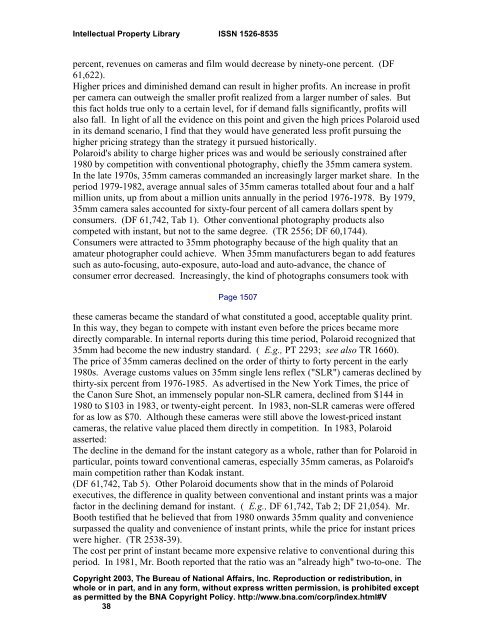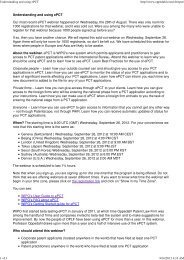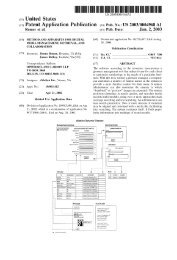Polaroid Corp. v. Eastman Kodak Co. - Oppedahl Patent Law Firm LLC
Polaroid Corp. v. Eastman Kodak Co. - Oppedahl Patent Law Firm LLC
Polaroid Corp. v. Eastman Kodak Co. - Oppedahl Patent Law Firm LLC
You also want an ePaper? Increase the reach of your titles
YUMPU automatically turns print PDFs into web optimized ePapers that Google loves.
Intellectual Property Library ISSN 1526-8535<br />
percent, revenues on cameras and film would decrease by ninety-one percent. (DF<br />
61,622).<br />
Higher prices and diminished demand can result in higher profits. An increase in profit<br />
per camera can outweigh the smaller profit realized from a larger number of sales. But<br />
this fact holds true only to a certain level, for if demand falls significantly, profits will<br />
also fall. In light of all the evidence on this point and given the high prices <strong>Polaroid</strong> used<br />
in its demand scenario, I find that they would have generated less profit pursuing the<br />
higher pricing strategy than the strategy it pursued historically.<br />
<strong>Polaroid</strong>'s ability to charge higher prices was and would be seriously constrained after<br />
1980 by competition with conventional photography, chiefly the 35mm camera system.<br />
In the late 1970s, 35mm cameras commanded an increasingly larger market share. In the<br />
period 1979-1982, average annual sales of 35mm cameras totalled about four and a half<br />
million units, up from about a million units annually in the period 1976-1978. By 1979,<br />
35mm camera sales accounted for sixty-four percent of all camera dollars spent by<br />
consumers. (DF 61,742, Tab 1). Other conventional photography products also<br />
competed with instant, but not to the same degree. (TR 2556; DF 60,1744).<br />
<strong>Co</strong>nsumers were attracted to 35mm photography because of the high quality that an<br />
amateur photographer could achieve. When 35mm manufacturers began to add features<br />
such as auto-focusing, auto-exposure, auto-load and auto-advance, the chance of<br />
consumer error decreased. Increasingly, the kind of photographs consumers took with<br />
Page 1507<br />
these cameras became the standard of what constituted a good, acceptable quality print.<br />
In this way, they began to compete with instant even before the prices became more<br />
directly comparable. In internal reports during this time period, <strong>Polaroid</strong> recognized that<br />
35mm had become the new industry standard. ( E.g., PT 2293; see also TR 1660).<br />
The price of 35mm cameras declined on the order of thirty to forty percent in the early<br />
1980s. Average customs values on 35mm single lens reflex ("SLR") cameras declined by<br />
thirty-six percent from 1976-1985. As advertised in the New York Times, the price of<br />
the Canon Sure Shot, an immensely popular non-SLR camera, declined from $144 in<br />
1980 to $103 in 1983, or twenty-eight percent. In 1983, non-SLR cameras were offered<br />
for as low as $70. Although these cameras were still above the lowest-priced instant<br />
cameras, the relative value placed them directly in competition. In 1983, <strong>Polaroid</strong><br />
asserted:<br />
The decline in the demand for the instant category as a whole, rather than for <strong>Polaroid</strong> in<br />
particular, points toward conventional cameras, especially 35mm cameras, as <strong>Polaroid</strong>'s<br />
main competition rather than <strong>Kodak</strong> instant.<br />
(DF 61,742, Tab 5). Other <strong>Polaroid</strong> documents show that in the minds of <strong>Polaroid</strong><br />
executives, the difference in quality between conventional and instant prints was a major<br />
factor in the declining demand for instant. ( E.g., DF 61,742, Tab 2; DF 21,054). Mr.<br />
Booth testified that he believed that from 1980 onwards 35mm quality and convenience<br />
surpassed the quality and convenience of instant prints, while the price for instant prices<br />
were higher. (TR 2538-39).<br />
The cost per print of instant became more expensive relative to conventional during this<br />
period. In 1981, Mr. Booth reported that the ratio was an "already high" two-to-one. The<br />
<strong>Co</strong>pyright 2003, The Bureau of National Affairs, Inc. Reproduction or redistribution, in<br />
whole or in part, and in any form, without express written permission, is prohibited except<br />
as permitted by the BNA <strong>Co</strong>pyright Policy. http://www.bna.com/corp/index.html#V<br />
38





